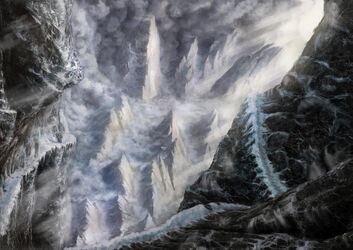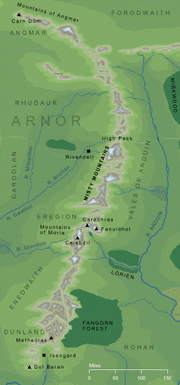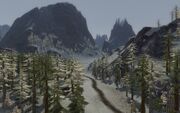The Misty Mountains, also named Hithaeglir (Sindarin: hîth, "mist", + aeglir, "range of mountain peaks"), was a mountain range stretching 1280 kilometres (796 miles) from Mount Gundabad in the far north to Methedras in the south of Middle-earth, between Eriador and Rhovanion.
An early version of these mountains' name was the Sindarin Ered Hithui.
Description
The range's notable peaks were Caradhras, Celebdil, Fanuidhol, Mount Gundabad, and Methedras.
Its most important passes were the High Pass and Redhorn Pass. There was also a pass at the source of the Gladden river.[1]

Clefts deep within the mountains, by Robert Zigo
Location
The northernmost peak of the Misty Mountains was Mount Gundabad; where according to legend Durin (eldest of the Seven Fathers of the Dwarves) awoke, though it later became an Orc-hold and mountain-fortress of Orcs.
The greatest Dwarven realm in Middle-earth, Khazad-dûm (later named Moria), was located at the midpoint of the Misty Mountains. The three peaks that were part of Khazad-dûm were Caradhras (Redhorn), Celebdil (Silvertine) and Fanuidhol (Cloudyhead). Inside Celebdil, the Dwarves built the Endless Stair, from the foundations of the mountain to the top of it. The southernmost peak of the Misty Mountains was Methedras, meaning "the Last Peak".[1]
Inhabitants
Under the Misty Mountains was the former Dwarf realm of Khazad-dûm (Moria), and the "Goblin-town" in which Bilbo Baggins stumbled across the One Ring, which had been in the possession of the creature Gollum, who also dwelt there himself on the eastern side.
Far below Moria or Goblin-town, in the uttermost foundations of stone, "nameless things" are said to have gnawed on the earth. One of the Balrogs (known later as Durin's Bane) which escaped the War of Wrath fled to the Misty Mountains, and hibernated beneath Moria for over 5,000 years, learning to navigate the tunnels made by nameless things.
The elven refuge of Rivendell was hidden in the foothills of the Misty Mountains at the western end of the High Pass. The High Pass itself was inhabited by "stone-giants", who threw rocks at each other during thunderstorms as a form of game, as told in The Hobbit.
Carn Dûm, where the Witch-king of Angmar resided for several centuries in the Third Age, lay between a western spur of the northern extreme of the range, known as the Mountains of Angmar. Mount Gundabad, the largest Goblin dwelling in the Misty Mountains, was located south-east of Angmar.
Isengard lay centered around the tower of Orthanc in Nan Curunír, the valley between the arms of Methedras, the southernmost of the Misty Mountains.

The Misty Mountains during the Third Age, on a map showing density of forests and grasslands
History
Origins
The Misty Mountains were created by Melkor during the Time of the Trees, who wanted to make it difficult for Oromë to pass, as he often rode across Middle-earth hunting the Dark Lord's fell beasts.[citation needed]
The first inhabitants of the Misty Mountains were nameless things, who lived below the earth supposedly before even Sauron entered Arda. They delved the first tunnels of the mountains, which the Orcs and Dwarves would later colonize and build upon, driving these nameless things to deeper darker corners without even knowing.
Years of the Trees
Later, when the Elves on their Great Journey to Valinor looked upon the mountains' terrible height, a portion of the Teleri, later known as the Nandor, grew afraid and turned southward down the Great River.
The Dwarves of Durin awoke upon a time underneath Mount Gundabad and would establish the realm of Khazad-dûm. Many centuries later, the Ñoldor returned to Middle-earth and established great realms in Beleriand and in the highlands, but never crossed the Misty Mountains or established realms close to them.
First and Second Ages
Over three-hundred years into the First Age, the tribes of Men crossed the Misty Mountains and began migrating into Beleriand, first the Edain and then later the Easterlings or "Swarthy Men". After the defeat of Morgoth, the surviving Orcs came to live in the mountains and would remain a problem for over six-thousand years. The Easterling men who fought with Morgoth crossed the mountains and began living east of Wilderland in Rhûn. The Great Eagles also began living here in many eyries, the most important of which was known as the Great Shelf.
The great Dwarven realm of Khazad-dûm beneath the Misty Mountains thrived as good relations with the Ñoldor of Eregion were established, until Sauron invaded Eriador from the south destroying Eregion and ravaging the lands beyond. The Dwarves survived by shutting themselves in Khazad-dûm behind the Doors of Durin.[2]
During the War of the Last Alliance, Sauron sent a force of Orcs to occupy the mountains and hinder any troops that tried to cross them. In the event, the main strength of Gil-galad and Elendil passed that way and the Orcs hid. Ultimately though, they would re-emerge to perpetrate the Disaster of the Gladden Fields.

The Misty Mountains northeast of Rivendell The Lord of the Rings Online
Third Age
In TA 1980, the great Dwarven realm of Khazad-dûm came to an end when the Dwarves unearthed a Balrog which led to its desertion by TA 1981, after which it was known as Moria (meaning "black chasm"). Slowly, the Misty Mountains became increasingly perilous and dangerous to travelers as orcs and other creatures came to dwell beneath them, constructing settlements such as Goblin-town.
Almost a thousand years later, the thirteen Dwarves, Gandalf, and Bilbo Baggins used the High Pass to cross the Misty Mountains during the Quest of Erebor and were captured by Orcs whilst crossing. Under the mountains, the Great Goblin was slain, and Bilbo found the One Ring.
After coming through Eregion, the Fellowship of the Ring tried to cross the Redhorn Pass (after rejecting the High Pass, as it was watched by the Enemy, and the Gap of Rohan would have taken the Fellowship too close to Isengard), but a blizzard forced them to go under the mountain instead of over it. Within Moria they faced the Balrog that dwelt in the deserted realm of Khazad-dûm. Gandalf slew the Balrog by casting it down from Zirakzigil, but it had worn his life already, and on that high ground he lay until Gwaihir bore him to Lothlórien, where he was renewed as Gandalf the White.
Trivia
- Led Zeppelin recorded a song, "Misty Mountain Hop", which borrows this name from Tolkien. Several other Led Zeppelin songs contain MIddle-earth references within their lyrics, such as "The Battle of Evermore" and "Ramble On".
- Robert Jordan's fantasy series The Wheel of Time also features a mountain range called the Mountains of Mist.
- The Misty Montes on Titan, Saturn's largest moon, are named after the Misty Mountains. This is from an IAU convention that names mountain ranges on Titan after mountain ranges from Tolkien's work.
Translations
| Foreign Language | Translated name |
| Afrikaans | Mistige Berge |
| Albanian | Malet e Mjegullt |
| Amharic | ጭጋግና ተራሮች |
| Arabic | جبال الضباب |
| Armenian | Մառախլապատ լեռներ |
| Azerbaijani | Dumanlı Dağları |
| Basque | Lausotu Mendiak |
| Belarusian Cyrillic | Туманныя горы |
| Bengali | কুয়াশাচ্ছন্ন পর্বতমালার |
| Bosnian | Maglovite planine |
| Bulgarian Cyrillic | Мъгливите планини (Misty Mountains)
Хисаеглир (Hithaeglir) |
| Burmese | နှင်းမြူခိုးတောင်တန်း |
| Catalan | Muntanyes Boiroses |
| Cebuano | Gabon nga kabukiran |
| Chichewa | Kwankhungu Mapiri |
| Chinese (Hong Kong) | 迷霧山脈 |
| Corsician | Muntagni Nebbia |
| Croatian | Maglovite planine |
| Czech | Mlžné hory |
| Danish | Tågebjergene |
| Dutch | Mistige Bergen |
| Estonian | UduMägede |
| Filipino | Maulap na bundok |
| Finnish | Sumuvuoret |
| French | Monts Brumeux |
| Frisian | Mistich Bergen |
| Galician | Montañas Enevoadas |
| Georgian | ნისლიანი მთები |
| German | Nebelgebirge |
| Greek | Ομιχλώδης βουνά |
| Gujarati | ઝાકળવાળું પર્વતો |
| Hindi | मिस्टी पहाड़ों |
| Hungarian | Köd-hegység |
| Icelandic | Þokufullurfjöll |
| Irish Gaelic | Sléibhte an Cheo |
| Italian | Montagne Nebbiose |
| Indonesian | Pegunungan Berkabut |
| Japanese | 霧ふり山脈 |
| Kannada | ಮಿಸ್ಟಿ ಪರ್ವತಗಳು |
| Kazakh | Тұманды таулар (Cyrillic) Tumandı tawlar (Latin) |
| Korean | 안개 낀 산 |
| Kurdish | Çiyayên Moranê (Kurmanji) |
| Kyrgyz Cyrillic | Тумандуу тоолор |
| Latin | Nebulosa Montes |
| Latvian | Miglains Kalni |
| Lithuanian | Rūkas Kalnuose |
| Luxembourgish | Niwweleg Bierger |
| Macedonian Cyrillic | Магливи Планини |
| Malayalam | മൂടൽമഞ്ഞ് പർവതങ്ങൾ |
| Malagasy | Zavona Tendrombohitra |
| Malaysian | Gunung Berkabus |
| Maltese | Muntanji Taċ-ċpar |
| Marathi | धुक्याचे डोंगर |
| Manx | Sleityn Fo-chay ? |
| Mongolian Cyrillic | хандаасай уулс |
| Nepalese | कुहिरो पहाडहरू |
| Norwegian | Tåkefjellene |
| Persian | کوه های مه آلود |
| Polish | Góry Mgliste |
| Portuguese | Montanhas Sombrias or Montanhas Nebulosas (Brazil) Montanhas Nebulosas (Portugal) |
| Punjabi | ਧੁੰਦ ਪਹਾੜ |
| Romanian | Munții Cețoși/Munții Pâcloși |
| Russian | Мглистые горы |
| Sanskrit | मास्तु मायात्मक |
| Scottish Gaelic | Beinntean a 'Cheò |
| Serbian | Маглене Планине (Cyrillic) Maglene Planine (Latin) |
| Sicilian | Muntagne Nebbiose |
| Sinhalese | මීදුම් සහිතය කඳුකරය |
| Slovak | Hmlisté hory |
| Slovenian | Meglene Gore |
| Somali | Buuraha ceeryaamo ah |
| Spanish (Spain and Latin America) | Montañas Nubladas |
| Swahili | Milima ya Ukungu |
| Swedish | Dimmiga Bergen |
| Tajik Cyrillic | Кӯҳҳои туман |
| Tamil | மூடுபனி மலைகள் |
| Tatar | Томанлы таулар |
| Telugu | పొగమంచుగల పర్వతాలు |
| Thai | เทือกเขามิสตี้ |
| Turkish | Puslu Dağlar |
| Turkmen | Dumanly Daglar |
| Ukrainian Cyrillic | Туманні гори |
| Urdu | دھندلے پہاڑ |
| Uzbek | Туманли Тоғлар (Cyrillic) Tumanli Tog'lar (Latin) |
| Welsh | Mynyddoedd Niwlog |
| Yiddish | נעפּלדיק בערג |
| Zulu | Nekungu izintaba |
| Mountain Ranges of Arda |
|---|
|
Ash Mountains | Blue Mountains | Echoriad | Ephel Dúath | Ered Gorgoroth | Ered Lómin | Ered Wethrin | Grey Mountains (north) | Grey Mountains (south) | Iron Hills | Iron Mountains | Misty Mountains | Mountains of Angmar | Mountains of Mirkwood | Mountains of Mithrim | Mountains of the Wind | Orocarni | Pelóri | Walls of the Sun | White Mountains | Yellow Mountains |
